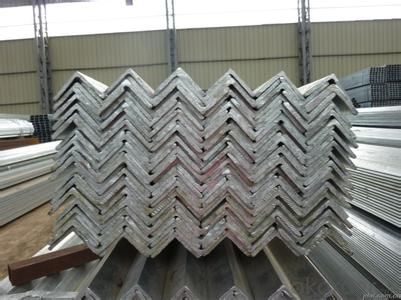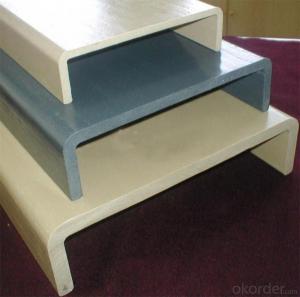Steel JIS U CHANNEL 50-300MM GB Standard JIS G3192
- Loading Port:
- Tianjin
- Payment Terms:
- TT or LC
- Min Order Qty:
- 25 m.t.
- Supply Capability:
- 200000 m.t./month
OKorder Service Pledge
OKorder Financial Service
You Might Also Like
Product Description:
OKorder is offering high quality Hot Rolled Steel I-Beams at great prices with worldwide shipping. Our supplier is a world-class manufacturer of steel, with our products utilized the world over. OKorder annually supplies products to European, North American and Asian markets. We provide quotations within 24 hours of receiving an inquiry and guarantee competitive prices.
Product Applications:
According to the needs of different structures, Angle can compose to different force support component, and also can be the connections between components. It is widely used in various building structures and engineering structures such as roof beams, bridges, transmission towers, hoisting machinery and transport machinery, ships, industrial furnaces, reaction tower, container frame and warehouse etc
Product Advantages:
OKorder's Steel I-Beams are durable, strong, and resist corrosion.
Main Product Features:
· Premium quality
· Prompt delivery & seaworthy packing (30 days after receiving deposit)
· Corrosion resistance
· Can be recycled and reused
· Mill test certification
· Professional Service
· Competitive pricing
Product Specifications:
Manufacture: Hot rolled
Grade: Q195 – 235
Certificates: ISO, SGS, BV, CIQ
Length: 6m – 12m, as per customer request
Packaging: Export packing, nude packing, bundled
Sizes: 25mm-250mm | ||||||||||||
a*t | ||||||||||||
25*2.5-4.0 | 70*6.0-9.0 | 130*9.0-15 | ||||||||||
30*2.5-6.6 | 75*6.0-9.0 | 140*10-14 | ||||||||||
36*3.0-5.0 | 80*5.0-10 | 150*10-20 | ||||||||||
38*2.3-6.0 | 90*7.0-10 | 160*10-16 | ||||||||||
40*3.0-5.0 | 100*6.0-12 | 175*12-15 | ||||||||||
45*4.0-6.0 | 110*8.0-10 | 180*12-18 | ||||||||||
50*4.0-6.0 | 120*6.0-15 | 200*14-25 | ||||||||||
60*4.0-8.0 | 125*8.0-14 | 250*25 | ||||||||||
FAQ:
Q1: What makes stainless steel stainless?
A1: Stainless steel must contain at least 10.5 % chromium. It is this element that reacts with the oxygen in the air to form a complex chrome-oxide surface layer that is invisible but strong enough to prevent further oxygen from "staining" (rusting) the surface. Higher levels of chromium and the addition of other alloying elements such as nickel and molybdenum enhance this surface layer and improve the corrosion resistance of the stainless material.
Q2: Can stainless steel rust?
A2: Stainless does not "rust" as you think of regular steel rusting with a red oxide on the surface that flakes off. If you see red rust it is probably due to some iron particles that have contaminated the surface of the stainless steel and it is these iron particles that are rusting. Look at the source of the rusting and see if you can remove it from the surface.
Q3: How do you package the angle steel when shipping?
A3: All goods are packed in bundles with steel strips and shipped by container or break bulk.


- Q:What are the different types of steel channel supports?
- There are several types of steel channel supports, including C-channel supports, U-channel supports, Z-channel supports, and hat channel supports. These supports are commonly used in construction and engineering projects to provide structural stability and support for various applications.
- Q:How do steel channels enhance the aesthetics of a building?
- The sleek and modern appearance of steel channels greatly enhances the aesthetics of a building. With their clean lines and smooth surfaces, steel channels create a visually appealing look that complements various architectural styles. One way in which steel channels enhance the aesthetics is by adding visual interest and depth to the building's facade. They can be used as decorative accents or architectural features, giving the overall design a distinct and contemporary touch. By strategically placing steel channels, architects and designers can create patterns or shapes that give the building a unique and captivating look. In addition, steel channels contribute to a sense of balance and proportion in the building's structure. Architects and designers can incorporate steel channels in specific locations to create a sense of symmetry or asymmetry, depending on the desired aesthetic outcome. This helps create a visually pleasing and harmonious composition. Furthermore, steel channels offer flexibility in terms of finishes and colors. They can be painted or coated in various shades, seamlessly blending with the overall color scheme of the building. This versatility allows for endless design possibilities and ensures that the steel channels can be tailored to meet the specific aesthetic vision of the project. Moreover, steel channels are highly durable and require minimal maintenance. Their long-lasting nature ensures that the building will maintain its aesthetic appeal for years to come. This durability also allows for the use of steel channels in both interior and exterior applications, providing a cohesive aesthetic throughout the entire building. In conclusion, steel channels enhance the aesthetics of a building by providing a sleek and modern appearance, adding visual interest and depth, contributing to balance and proportion, offering versatility in finishes and colors, and ensuring long-lasting durability. Overall, steel channels are a valuable architectural element that greatly enhances the overall aesthetics of any building.
- Q:How do steel channels perform in extreme temperature variations?
- Steel channels are known for their excellent performance in extreme temperature variations. The unique properties of steel, such as its high melting point and thermal conductivity, allow steel channels to withstand extreme temperatures without significant deformation or damage. In high-temperature environments, steel channels exhibit remarkable stability and strength. They can resist the effects of thermal expansion and contraction, which can cause other materials to warp or crack. The thermal conductivity of steel also allows for efficient heat transfer, which helps in dissipating excess heat and maintaining the structural integrity of the channels. Similarly, in low-temperature conditions, steel channels remain robust and do not become brittle like some other materials. This is due to the ductility of steel, which enables it to withstand the stresses caused by temperature changes without fracturing or breaking. Additionally, steel channels can maintain their shape and structural integrity even in extremely cold environments, making them highly suitable for various applications. Overall, steel channels have proven to be reliable and perform exceptionally well in extreme temperature variations. Whether it is enduring high temperatures or withstanding freezing conditions, steel channels are a preferred choice due to their strength, stability, and ability to resist thermal expansion and contraction.
- Q:Are steel channels prone to rusting?
- Yes, steel channels are prone to rusting. Steel is primarily made of iron, and when exposed to moisture or oxygen, it can undergo a chemical reaction known as oxidation, which leads to the formation of rust. Rusting weakens the steel structure, making it more susceptible to corrosion and eventual failure. Therefore, steel channels need to be protected from moisture and other corrosive elements using appropriate coatings or treatments to prevent rust formation and prolong their lifespan.
- Q:Can steel channels be used in telecommunications towers?
- Yes, steel channels can be used in telecommunications towers. Steel channels have a range of applications due to their strength, durability, and versatility. In telecommunications towers, steel channels can be used for structural support, providing stability and load-bearing capacity for the tower. The channels can be fabricated and assembled to form the framework of the tower, allowing for the installation of various equipment such as antennas, transmitters, and receivers. Additionally, the design of steel channels allows for easy integration of cables and wiring, facilitating efficient connectivity throughout the tower. Overall, the use of steel channels in telecommunications towers ensures a sturdy and reliable infrastructure for efficient and effective communication networks.
- Q:How many meters per ton is channel ten?
- Channel ten is about 100 meters per ton.
- Q:Can steel channels be used for racking and shelving systems?
- Yes, steel channels can be used for racking and shelving systems. Steel channels are often used in the construction of industrial storage systems due to their strength and durability. They provide a sturdy framework for supporting heavy loads and can be easily customized to fit the specific dimensions and requirements of a racking or shelving system. Steel channels also offer excellent resistance to corrosion and can withstand harsh environmental conditions, making them suitable for long-term use. Additionally, their modular design allows for easy installation and reconfiguration, providing flexibility for future expansion or modification of the storage system. Overall, steel channels are a reliable and efficient choice for racking and shelving systems in various industrial and commercial settings.
- Q:What are the advantages of channel steel?
- According to the structure theory of channel, point in the wing section, i.e. channel should be upright, not lying. Therefore, the channel steel can change the structure of the building and save the building materials.
- Q:Can steel channels be used in staircase construction?
- Yes, steel channels can be used in staircase construction. Steel channels are often used as stringers or supports for staircases. They provide strength and stability to the staircase, making them a popular choice for both residential and commercial buildings. Steel channels are known for their durability and ability to withstand heavy loads, which makes them suitable for staircase construction. Additionally, steel channels can be easily fabricated and customized to fit specific design requirements, allowing for flexibility in staircase design.
- Q:How is a steel channel made?
- Hot rolling is the typical method used to produce a steel channel. The process commences by heating a large rectangular steel billet until it reaches a malleable temperature. Subsequently, the billet is passed through a sequence of rollers that gradually transform it into the desired channel shape. Throughout the hot rolling process, the rollers continually squeeze and elongate the billet, resulting in a reduction in thickness and an increase in length. The final shape of the channel is determined by the grooves on the rollers. The channel section can range from a simple C-shape to more intricate U-shapes or even customized profiles. As the billet takes shape, any surplus material is expelled through the sides, leaving behind a well-defined and clean channel shape. To prevent warping or distortion during the rolling process, the channel is consistently cooled. Once the desired length is attained, the channel is cut into individual pieces according to the specific requirements of the customer. Following the hot rolling process, additional treatments may be applied to the steel channels, such as straightening, surface cleaning, or coating. These treatments ensure that the channels meet the desired specifications and are ready for use in various applications, including structural support, construction, and manufacturing. In summary, the hot rolling process plays a vital role in the production of steel channels, enabling the fabrication of sturdy and adaptable structural components that find application in multiple industries.
1. Manufacturer Overview |
|
|---|---|
| Location | |
| Year Established | |
| Annual Output Value | |
| Main Markets | |
| Company Certifications | |
2. Manufacturer Certificates |
|
|---|---|
| a) Certification Name | |
| Range | |
| Reference | |
| Validity Period | |
3. Manufacturer Capability |
|
|---|---|
| a)Trade Capacity | |
| Nearest Port | |
| Export Percentage | |
| No.of Employees in Trade Department | |
| Language Spoken: | |
| b)Factory Information | |
| Factory Size: | |
| No. of Production Lines | |
| Contract Manufacturing | |
| Product Price Range | |
Send your message to us
Steel JIS U CHANNEL 50-300MM GB Standard JIS G3192
- Loading Port:
- Tianjin
- Payment Terms:
- TT or LC
- Min Order Qty:
- 25 m.t.
- Supply Capability:
- 200000 m.t./month
OKorder Service Pledge
OKorder Financial Service
Similar products
New products
Hot products
Related keywords





























